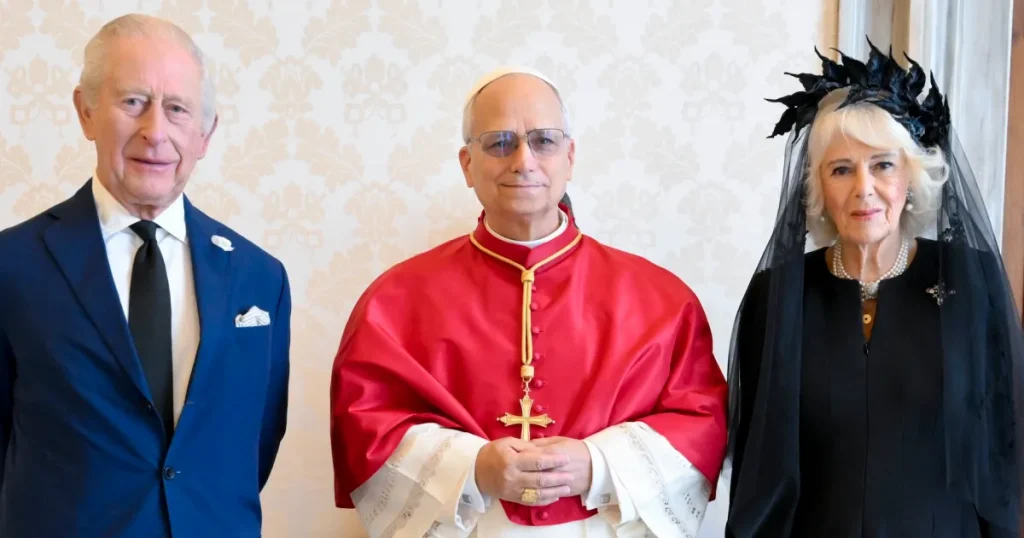A Historic Royal Meeting at the Vatican: King Charles III and Queen Camilla Bridge Centuries of Division
In a momentous diplomatic and religious occasion, King Charles III and Queen Camilla embarked on a significant journey to the Vatican, where they met with Pope Leo XIV on Thursday, October 23. The royal couple, aged 76 and 78 respectively, displayed warm cordiality as they greeted the Pope, their handshake captured by media outlets including ABC News. This visit stands as a watershed moment in the complex history between the Anglican and Catholic churches, as Charles became the first British monarch in over five centuries to pray publicly alongside a Pope. The symbolic weight of this meeting cannot be overstated—it represents the most significant step toward reconciliation between these Christian denominations since their traumatic separation during the English Reformation under Henry VIII. The royal couple participated in a Prayer Service at the iconic Sistine Chapel within the Apostolic Palace the day prior, where the Pope presented Charles with meaningful gifts, including a specially crafted seat featuring the King’s coat of arms in the historic Basilica of Saint Paul Outside the Walls.
The royal visit to Italy began on Wednesday when the couple arrived to a carefully prepared welcome. Buckingham Palace had issued a statement emphasizing the profound importance of this diplomatic mission, particularly notable as it proceeded despite ongoing family controversies back in London involving Prince Andrew. “His Majesty is greatly looking forward to meeting Pope Leo and celebrating together the historical significance of this visit, representing, as it does, such a landmark in relationships between the Church of England and the Catholic Church, and between the U.K. and the Holy See,” a palace spokesperson announced. The statement continued to highlight the broader significance of Christian unity in challenging global times: “At times of such global challenge, it has seldom been more important for Christian communities around the world to unite in faith and in fellowship with our partners.” Upon their arrival at the Italian airport, the King expressed his pleasure at returning to Rome, remarking, “It is wonderful to be able to come back to Rome.” This visit followed a previous trip earlier in the year, which had taken place shortly before the death of Pope Francis in April.
The timing of this historic visit carried additional complexity, coming just days after Prince Andrew, the King’s brother, relinquished his royal title amid continuing controversy surrounding his association with convicted sex trafficker Jeffrey Epstein. While neither Charles nor Camilla has publicly addressed this family crisis, it casts an unavoidable shadow over what would otherwise be an unmitigated diplomatic triumph. Andrew, age 65, announced his decision to step back permanently from royal life in a formal statement released on October 17: “In discussion with The King, and my immediate and wider family, we have concluded the continued accusations about me distract from the work of His Majesty and the Royal Family. I have decided, as I always have, to put my duty to my family and country first.” The former Duke of York referenced his initial withdrawal from public duties five years earlier when allegations first surfaced connecting him to Epstein’s criminal activities.
The royal family’s domestic turmoil stands in stark contrast to the historic religious reconciliation being pursued in Rome. The meeting between King Charles and Pope Leo represents the culmination of decades of careful diplomatic work to heal the wounds that have divided Christianity since the 16th century. As Supreme Governor of the Church of England, Charles occupies a position created specifically to replace papal authority in England. That these two religious leaders can now meet in fellowship and prayer demonstrates remarkable progress in interfaith relations. The King’s willingness to bring Anglican church leaders to meet with their Catholic counterparts further underscores his commitment to religious dialogue and cooperation. This aspect of Charles’s reign appears to reflect his long-stated personal philosophy of inclusivity and respect for diverse faith traditions—values he has advocated throughout his public life.
The specific timing of this visit also carries symbolic weight within the Catholic calendar, coming as preparations begin for the upcoming Jubilee Year in 2025, a special period in Catholic tradition designated for spiritual renewal and reconciliation. By participating in this moment, the British monarchy signals its respect for Catholic traditions while maintaining its own distinctive Anglican identity. The gift of a seat bearing the royal coat of arms within a major Roman basilica represents a physical embodiment of this new relationship—creating a permanent reminder of this historic meeting within one of Catholicism’s most sacred spaces. For both institutions, balancing tradition with meaningful reform has presented ongoing challenges, making this meeting all the more significant as a model for how ancient institutions can evolve while honoring their distinctive histories.
While the visit celebrates religious reconciliation, it occurs against a backdrop of continuing personal allegations against Prince Andrew that have cast a shadow over the royal family. The recent posthumous memoir by Virginia Giuffre, who died by suicide in April, has brought renewed attention to her previous allegations of sexual misconduct against Andrew involving encounters allegedly arranged through Jeffrey Epstein. Andrew has consistently denied these accusations, stating in his recent announcement: “With His Majesty’s agreement, we feel I must now go a step further. I will therefore no longer use my title or the honors which have been conferred upon me. As I have said previously, I vigorously deny the accusations against me.” This difficult family situation demonstrates the complex interplay between the royal family’s public responsibilities and private challenges. Even as King Charles works to advance significant diplomatic and religious goals abroad, he must simultaneously navigate serious family controversies at home, embodying the unique pressures faced by modern monarchs who must balance their institutional roles with the messy realities of family dynamics under intense public scrutiny.


